Our Clothes – From Closets to Landfills
Find free clothes and donate your own! Add sustainability to your wardrobe this season with the clothing swap rack by COD’s Fashion Activists.
November 7, 2022
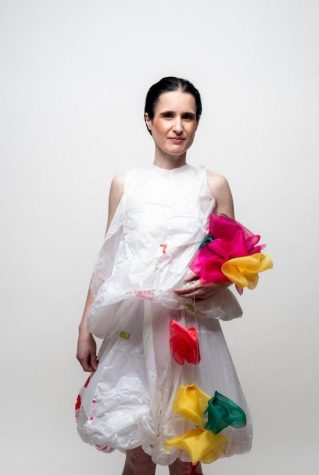
On display is a delicate white dress patterned with blocks of red text, “No Thank You” written over and over. A similar dress has colorful organza flowers down one side. This dress is made of plastic shopping bags. The designer of this eccentric piece is COD fashion student, Rahaf Damra.
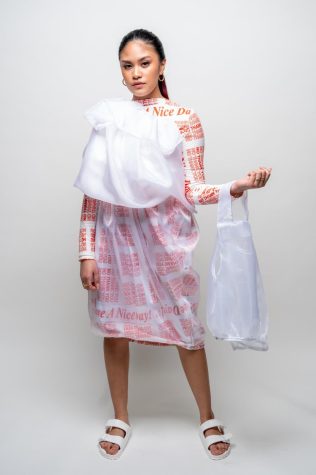
“Making it was difficult because I didn’t want to explicitly show a certain store branding on the bags to distract from the design,” Damra explained. “Laying out the bags and figuring out how to carefully sew without tearing them took time and patience.”
Damra is nearing the completion of her degree and has created many pieces, some of which were displayed at the August 2022 Fashion Show. Her plastic bag dress is designed to not only be thought-provoking but also encourage reusing materials, like plastic bags, to be more sustainable.
“We should all recognize the multiple functions things around us can serve rather than throwing them away,” Damra explained.
This is a central theme of FASHI-1821, Sustainability in Fashion, taught by Professor Stacia Farrar. Students explored the ways their fashion designs and personal wardrobes can be environmentally sustainable.
One of them is Elizabeth Herwaldt, and she’s also in the student-run Fashion Activism Group. She described how their professors encourage them to think critically about issues in the clothing industry and reflect on what actions they can take.
“They encourage you to think outside the box for creative solutions,” Herwaldt said.
Damra also described her classes with Professor Eva Stevens, the Fashion Studies department chair.
“In Eva’s classes, she’s been discussing ethical labor and sustainability well before the popularity of sustainability began,” Damra asserted. “She does it in a way that really makes you think and gather your own opinions on the matter.”
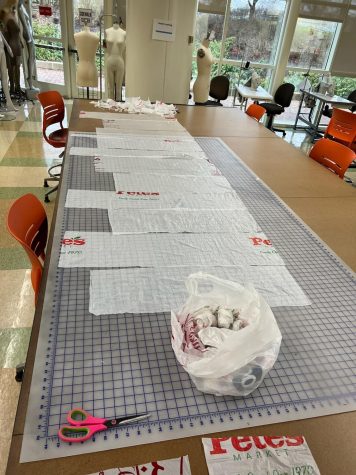
One of their assignments this semester was to upcycle a garment, meaning resew or upgrade it so it can be worn again.
“I took an old homecoming dress and reworked it into a dress I could get more wear out of,” Herwaldt described. “One of my classmates turned some jeans into a fanny pack.”
Learning from projects like these, the Fashion Activism Group created the clothing swap rack in the SRC Fashion hallway. The group was led by Mona Alshorah, a fashion studies student.
“My hope for the Fashion Activism Group is that it’s self-sustaining,” Alshorah said. “As students go to College of DuPage then graduate, they’re still interested in learning about the garments they wear and how they impact the world.”
She mentioned environmental effects, specifically microplastics. In the sustainability class, Herwaldt also learned how microplastics are produced when clothes are washed and then pollute water.
“As a solution to this problem, I wrote a proposal for companies to put microplastic filters on all washing machines,” Herwaldt explained.
Alshorah said the knowledge gained in the Sustainability and the Product Development classes was her biggest motivator for starting the Fashion Activism Group.
“They worked great to understand why it’s so difficult to implement sustainability in the fashion industry and how there’s lack of transparency in regulation,” Alshorah explained. “I wanted to make a difference, and I wanted to start at COD because that’s where I learned all these things.”
This semester, Eva Stevens spread the word about the clothes rack, after the neighboring Fuel Pantry expressed a growing need for donated winter wear.
“I put out a call for coats of all sizes and asked our FT faculty members to print a poster letting students know the rack exists and how it works,” Stevens explained.
Seeing the continuous donations and positive response has been encouraging for the Fashion Activism students.
“It’s fun for us to watch the different types of clothes that make their rounds through the rack,” Herwaldt said. “It almost created a community for fashion students to go like, ‘Look at this, it would look cute on you.’”
The fashion students’ biggest tips to encourage sustainable habits is to cherish the apparel they already own.
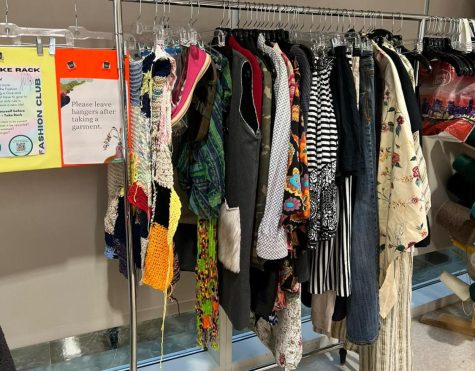
“Take a step back from your closet and ask yourself, ‘Do I actually need to buy something new, or is there something I can reuse?’” Herwaldt said.
Herwaldt encouraged people to avoid buying new items for every party and be conscious of what they purchase. She also gave tips to accessorize clothes with jewelry or temporary fixes with basic stitching, so they create their own fashion style instead of following every passing trend. By finding clothes they value and consistently wear, people feel more fulfilled. This is called dopamine dressing, which COD fashion studies alumna, Neelofar Syed, described.
“I wrote a paper once about a trend called dopamine dressing. Part of the trend is rediscovering what you already own, which is better for the environment than throwing away your ‘unloved’ clothes,” Syed explained.
According to the latest data by the U.S. Environmental Protection Agency, 11.3 million tons of textiles ended up in landfills in 2018, while only 2.51 million tons were recycled. When the clothes begin to rot, synthetic fabrics release emissions and pollute the soil.
Michelle Gonzalez is a sophomore who has enjoyed taking fashion studies classes at COD. She’s inspired by the creativity of fashion designers but worried by the effect of unbought products that brands throw out.
“Instead, they should make something new out of it,” Gonzalez said. “Donate what remains to an organization that supports sustainability or thrift it, like many young people are today.”
Even with sustainable options becoming common, there are other problems.
“Truly sustainable clothes are going to be super expensive,” Syed said. “So, people lean towards the more affordable fast fashion or poorly made clothes.”
Fast fashion is the industry model of cheap clothing that is rapidly mass-produced, often through unethical labor. A 2019 report by the World Resources Institute detailed the environmental, economic, and social impacts of global fast fashion.
Alshorah explained the problem goes beyond mass-production. It also includes people’s overconsumption and disposal of clothes, from closets to landfills.
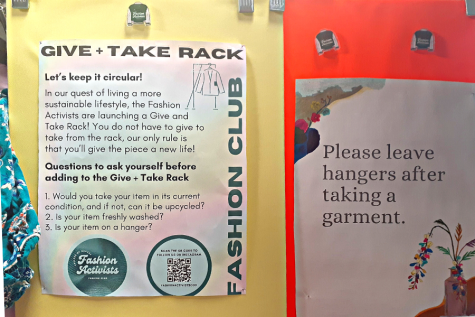
“It’s better to invest in pieces you can wear for a long time,” she said.
However, she pointed out two factors that prevent people from doing so. Some people may lack the money or time to seek out sustainable clothing brands or thrift stores. It may be more convenient for people to use the online economy behind fast fashion which delivers right to their door. Alshorah hopes that grassroot efforts like the clothing swap rack can create accessible options for people to trade their clothes.
“The whole point is to encourage sustainable action. People know the items that they give benefit others,” she said. “Hopefully they feel grateful for the generosity of people in the community.”
Alshorah and other Fashion Activist members hope to expand the rack swap idea to other colleges and promote small business fashion designers as two sustainable solutions. Students can connect with the Fashion Activists Group over Instagram, to work together to build a sustainable future for fashion.





















Kas • Nov 8, 2022 at 9:58 am
How do I take part